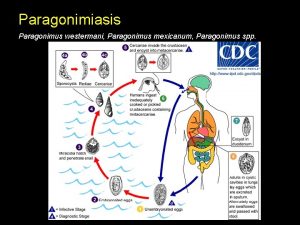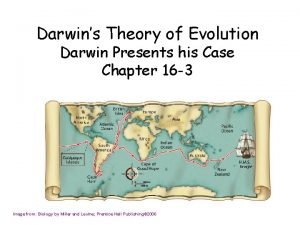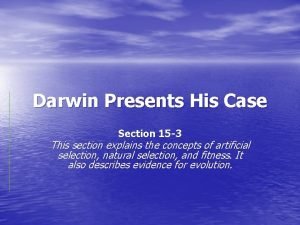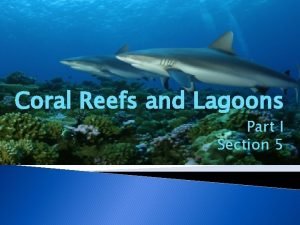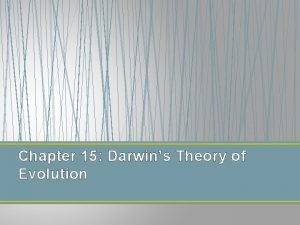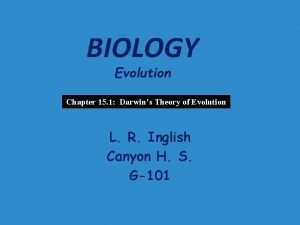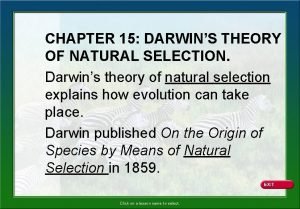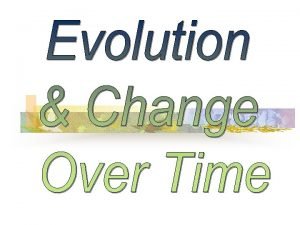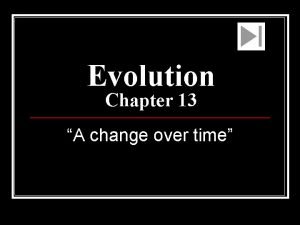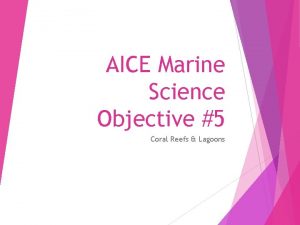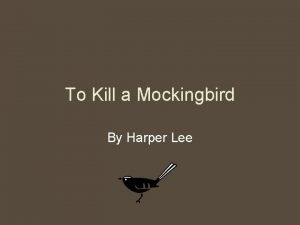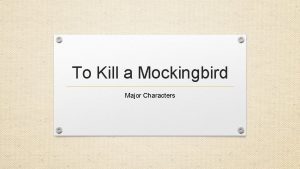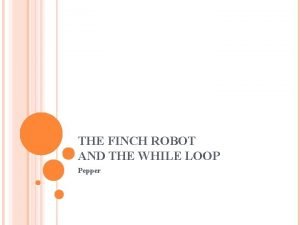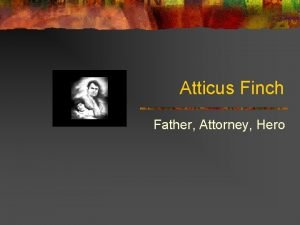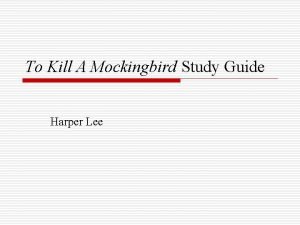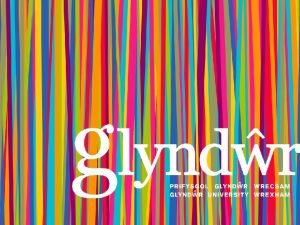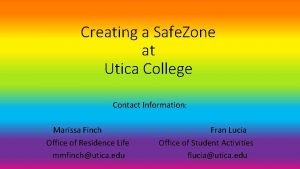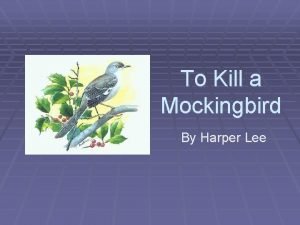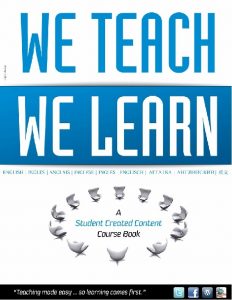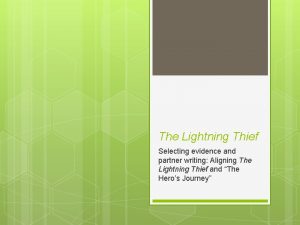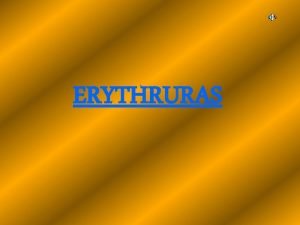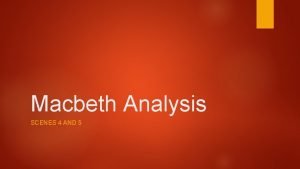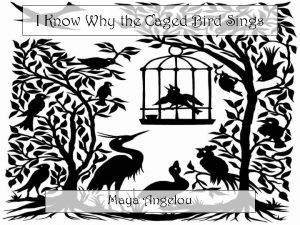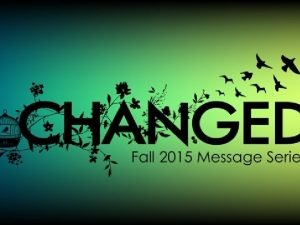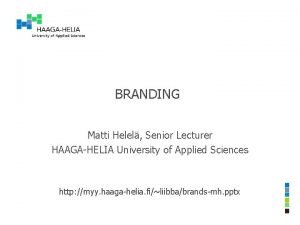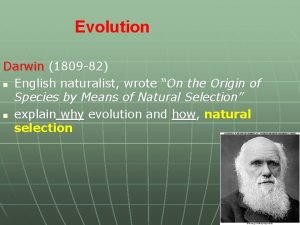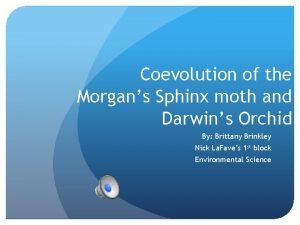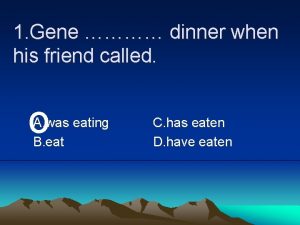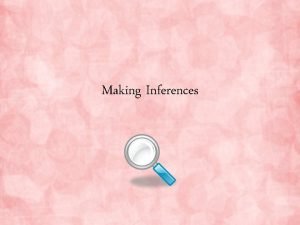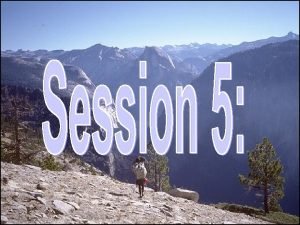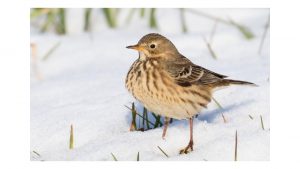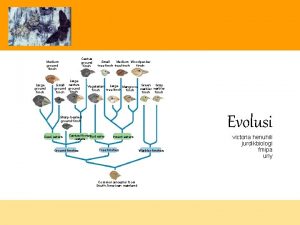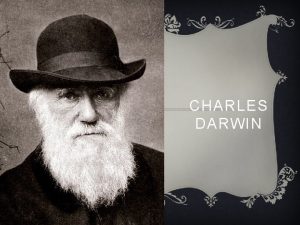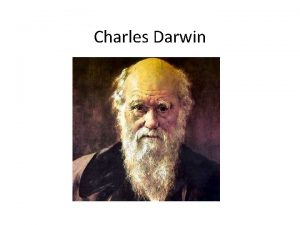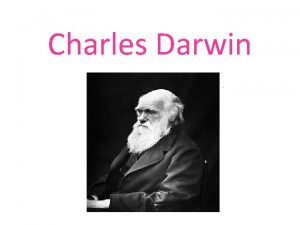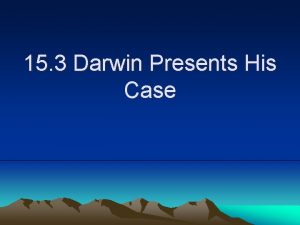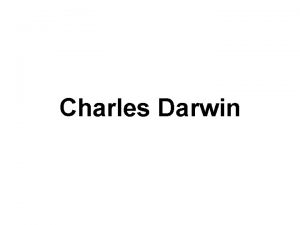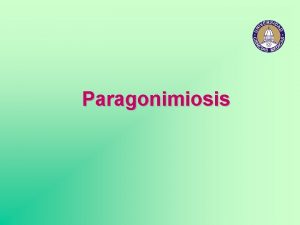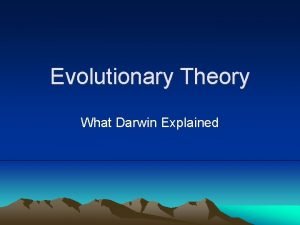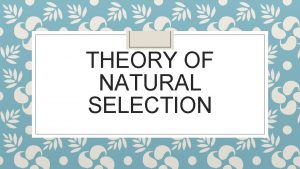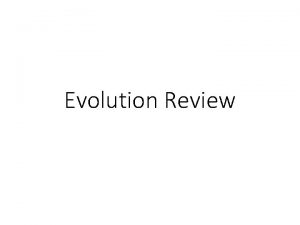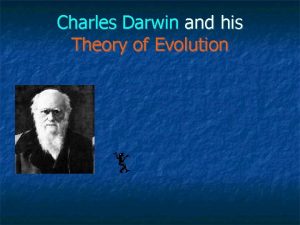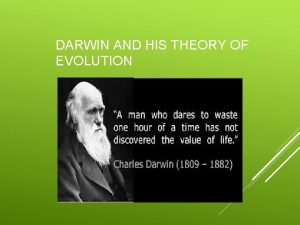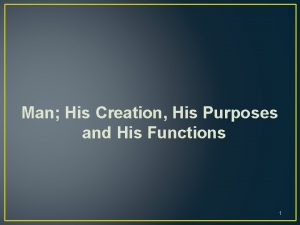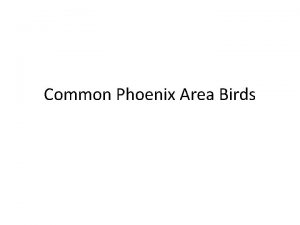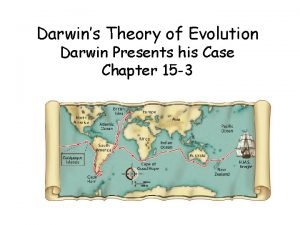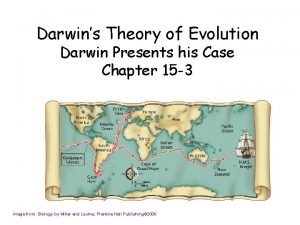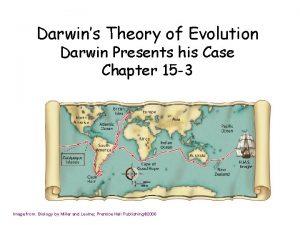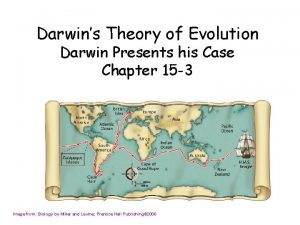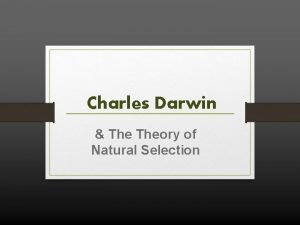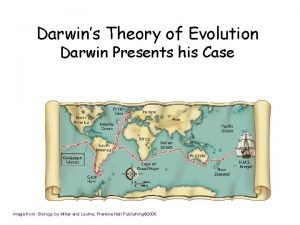House Finch Carpodacus mexicanus Darwin and His Theory
























































- Slides: 56

House Finch (Carpodacus mexicanus)

Darwin and His Theory

What is a Scientific Law? • Proven explanation or statement that expresses a fundamental principle of science. • Law of Gravity • Newton’s Laws of Motion

What is a (Scientific) Theory? • A well tested explanation that unifies a broad range of observations • Based on proven hypothesis • Multiple sources of independent verification • Generally accepted as true in science – Plate Tectonics, General Relativity, Atomic, – Germ theory of Disease

What is a hypothesis(Science)? • A proposed explanation that can be tested. • Hypothesis and Theory are not used correctly/scientifically in many applications. • A different meaning of the term hypothesis is used in formal logic, to denote the antecedent of a proposition; thus in the proposition "If P, then Q", P denotes the hypothesis (or antecedent); Q can be called a consequent. P is the assumption in a (possibly counterfactual) What If question.

What is a Belief? • To have confidence or faith in the truth • To have conviction, to suppose or to assume. • Proof, testing not required

As a scientist, as a thinker • • Know, be aware of your knowledge. Is what you know(or think you know) based on: Fact Law Theory Hypothesis Belief

Ignorance • lack of knowledge, learning, information.

In Science: • We are studying facts, theories, hypotheses. • We are not studying beliefs

Early European Middle Age Science • Early leading scholars were clergymen first, nature or the study of the natural world was a small part of their interest. • Science work relied heavily on knowledge from the Greeks, thousands of years before. • Influence of religion was very strong, any theory had to be approved by “The Church”.

Ancient Concept of the Universe

History of Persecution for New Ideas • As scientific knowledge grew and theories were developed, many were unwilling to accept this new knowledge.

Copernicus • 1514 – Developed theory that the Sun is the center of the Solar System, not the Earth • Didn’t publish book until 1543, as he was dying • Afraid of what would happen to him with this “new” knowledge

Galileo • 1616. The statements of Copernicus were condemnned, "until they should be corrected“ • Placed under house arrest for teaching/believing Copernican theory

Archbishop James Ussher(1581 -1656) • Calculated the age of the Earth • Based on an intricate correlation of Middle Eastern and Mediterranean histories and The Bible

Ussher’s Calculations • Earth had come into creation around six thousand years earlier (on October 22, 4004 B. C. to be precise) • Fossils were the remains of animals that had perished during the Biblical flood.

Ussher • These calculations and statements are not directly from the Bible • The work of one man • No peer review, no confirmation by independent research • Not science

Charles Darwin • 1809 – 1882 • Medical School Dropout • Interest in the natural world • Job as the naturalist aboard the HMS Beagle

Scientists influencing Darwin

James Hutton (1726– 1797) • Founder of Modern geology • Earth very old • Fossils are remains of ancient life forms • More recent fossils are similar to living organisms • Ancient fossils are very different • Sediments turn into rock slowly

Lamarck • 1809 published book on inheritance • Flawed, but includes concept of change over time for organisms

Lyell • 1833 – Principles of Geology • Uniformitarianism – The present is the key to the past

HMS Beagle • 5 year voyage to South America • Left England 12 -27 -1831 • Scientific expedition of South America • Study landforms/geology, water, biology • Observe, study, collect specimens of plants and animals

Galapagos Islands • Volcanic islands over 500 miles west of Ecuador

Galapagos Islands


Galapagos Islands • Equatorial • 15 different islands with a wide variety of land forms, microclimates and variations in living organisms

Galapagos Ecosystems

Galapagos Islands • Geologically young – much younger than South America


Darwin’s Observations • Patterns of Diversity – Many types of plants and animals well suited to their environments – Different types of plants and animals from what had been seen in S. A. and Australia, Europe – Traits of animals on different islands could be used to identify what island they came from • Tortoise shell types • Finch beaks

Observations, cont. • Distinct difference in the same types of birds on different islands • Brought back specimens for additional study

Questions • What questions would you have if you had taken this voyage and made these observations?

Darwin • After Beagle voyage, Darwin works on book describing Galapagos geology and biology • Develops ideas/hypotheses regarding species change over time • Others have similar thought/work at this time

On the Origin of Species • Published 1859 • Is initially a big hit, all 1250 copies initially printed sold out the first day • Scientists generally supported Darwin, some members of the Church of England spoke out against Darwin

Concepts in the book

Inherited Variation • Different members of the same species vary from one another in important ways. – Some cows give more milk – Some horses are faster than others – Artificial Selection is where humans select traits in plants/animals they want to keep/improve.

Struggle for Existence • Plant/animals in wild compete for resources necessary for survival • Competition is tough

Survival of the Fittest • Fitness – ability of the individual to survive and reproduce • Adaptation – an inherited characteristic that an organism has that increases its chance for survival • Individuals with the set of adaptations that are best for the environment survive and reproduce, others do not

Natural Selection • Competition in the natural world causes some individuals to survive and reproduce, and others to not survive/reproduce. • This causes a change in the inherited characteristics of species over time – many, many successive generations

Descent With Modification • Over long time periods, living species change from the ancestor species they are related to.

Common Descent • Similar organisms have the same ancestor species at some point in the past • At some point, all organisms have a common ancestor. • A single “tree of life” connects all life on Earth

Evolution • General definition – Change over time – Not all change through time, however, is evolutionary; the water cycle, the rotation of the earth around the sun, the metamorphosis of insects and other invertebrates likewise involve change through time, but these should not be confused with “evolution. ”

Controversy • At the time of publishing, Darwin was proposed for knighthood, opposed by head of Church of England • Evolution vs. Creationism

Scopes “Monkey Trial” 1925, Tennessee • http: //law 2. umkc. ed u/faculty/projects/ft rials/scope s. htm

National Academy of Sciences • Today, many religious denominations accept that biological evolution has produced the diversity of living things over billions of years of Earth’s history. Many have issued statements observing that evolution and the tenets of their faiths are compatible. Scientists and theologians have written eloquently about their awe and wonder at the history of the universe and of life on this planet, explaining that they see no conflict between their faith in God and the evidence for evolution. Religious denominations that do not accept the occurrence of evolution tend to be those that believe in strictly literal interpretations of religious texts.

http: //www. telegraph. co. uk/ • The Vatican claims Darwin's theory of evolution is compatible with Christianity

Evidence For Evolution • • • Fossils Geographic distribution of Species Anatomical similarities Embryological similarities Genetic similarities

Evidence of Evolution • Fossil Record – Change in type of life over time – Transitional fossils showing stages of life – Radiometric dating

Evidence of Evolution • Geographic distribution of Living Species – Similar features to organisms living in similar environments – pg 383 – beaver/muskrat/capybara/coypu

Homologous Body Structures • Limbs of different species have similar structures, similar embryological source. • Change by adaptation, evolution from common ancestor • Pg. 384

Embryological Similarities


Genetic Similarity • … lineage leading to modern humans we infer the gain of 689 genes and the loss of 86 genes since the split from chimpanzees, including changes likely driven by adaptive natural selection. Our results imply that humans and chimpanzees differ by at least 6% (1, 418 of 22, 000 genes) in their complement of genes, which stands in stark contrast to the oft-cited 1. 5% difference between orthologous nucleotide sequences. This genomic “revolving door” of gene gain and loss represents a large number of genetic differences separating humans from our closest relatives. • • The Evolution of Mammalian Gene Families http: //www. plosone. org/article/info%3 Adoi%2 F 10. 1371%2 Fjournal. pone. 0000085

Humans did not evolve from monkeys

As you grow and learn: • Check yourself – do you base your knowledge on fact, theory, belief? • Know when you are using your fact based system, and when you are using your belief based system.
 Huevo de paragonimus westermani
Huevo de paragonimus westermani 16 3 darwin presents his case answer key
16 3 darwin presents his case answer key 15-3 darwin presents his case
15-3 darwin presents his case Strengths and weaknesses of evolutionary theory page 386
Strengths and weaknesses of evolutionary theory page 386 How are atoll formed
How are atoll formed Chapter 17 darwin's theory of evolution
Chapter 17 darwin's theory of evolution Chapter 15 darwin's theory of evolution section 15-1
Chapter 15 darwin's theory of evolution section 15-1 Homologous structures definition biology
Homologous structures definition biology Charles darwin theory of evolution
Charles darwin theory of evolution Natural selection
Natural selection Examples of homologous structures
Examples of homologous structures Darwin's theory of evolution
Darwin's theory of evolution Darwin-dana-daly theory
Darwin-dana-daly theory Jvs scarborough
Jvs scarborough In southern gothic atticus finch and miss maudie represent
In southern gothic atticus finch and miss maudie represent Finch family cook, maid and nanny
Finch family cook, maid and nanny Scout finch strengths and weaknesses
Scout finch strengths and weaknesses Discount houses in money market
Discount houses in money market Jean louise to kill a mockingbird
Jean louise to kill a mockingbird Qualities of atticus finch
Qualities of atticus finch To kill a mockingbird jean louise
To kill a mockingbird jean louise Chapters 4-7 to kill a mockingbird summary
Chapters 4-7 to kill a mockingbird summary Atticus finch family tree
Atticus finch family tree Atticus finch family tree
Atticus finch family tree Frances cunningham finch
Frances cunningham finch Finch robot download
Finch robot download 1,000 species of finch have been identified.
1,000 species of finch have been identified. Jennie finch slow motion
Jennie finch slow motion Atticus finch background
Atticus finch background What happens to tom robinson in chapter 23
What happens to tom robinson in chapter 23 Direct characterization in to kill a mockingbird
Direct characterization in to kill a mockingbird Catrin finch centre wrexham
Catrin finch centre wrexham Shari finch
Shari finch Diana finch
Diana finch Dr andrew finch
Dr andrew finch Marissa finch utica college
Marissa finch utica college Jean louise scout finch character traits
Jean louise scout finch character traits Andrew finch
Andrew finch Gus mccrae quotes
Gus mccrae quotes Y hembra
Y hembra Marc performs poorly on a psychology exam
Marc performs poorly on a psychology exam Lady macbeth analysis act 1 scene 5
Lady macbeth analysis act 1 scene 5 Mi nombre la casa en mango street
Mi nombre la casa en mango street Caged bird metaphors
Caged bird metaphors Snug bug homes
Snug bug homes Banished boarding house
Banished boarding house My house shall be called
My house shall be called They went house to house
They went house to house Helel keller
Helel keller Darwin and evolution
Darwin and evolution Morgans sphinx moth
Morgans sphinx moth Darwin vs lamarck
Darwin vs lamarck Kyle ran
Kyle ran On alberto's drive to his aunt's house
On alberto's drive to his aunt's house At one time mr roberts this building
At one time mr roberts this building What is an inference? *
What is an inference? * Moses was faithful in all his house
Moses was faithful in all his house
